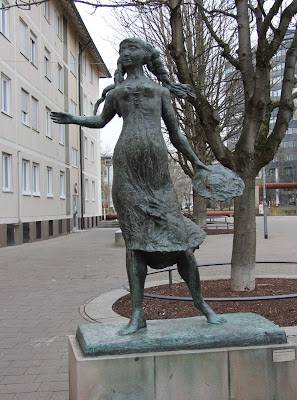The city of Heilbronn is famous for two things: its wine and Käthchen. Käthchen is the eponymous main character from a play written by Heinrich von Kleist: Das Kätchen von Heilbronn (Little Kate of Heilbronn). I didn't try the wine, being sceptical of any German wine (I like my wine Italian, dark, and extremely quaffable). But I met Käthchen or at least what the artist Dieter Läpple in 1965 thought she might look like (although I have some doubts that any overly rich Count would fall for this innocent looking child except if he was a pedophile):
And I can tell you this much: in the end Little Kate gets the Count she is stalking.
Heilbronn lies beautifully at the River Neckar
and has some nice buildings, too. For example the church of Kilian:
although originally built in the 11th century, most of what you can see today (if you have the chance to glimpse through the construction fence) is from the 15th and 16th century. They also have a beautiful city hall with a really nice astronomical clock:
There are statues and various art works throughout the city. I especially liked the 'Closed Gate' by Michael Schoenholtz from 1989, not so much because it looks like an open gate at best to me, but because it reminds me a bit of Stonehenge:
Of course, Heilbronn also has modern shopping centres
and interesting fountains. This one at the marketplace was dedicated to Robert Mayer. Mayer and in England Joule, had both at roughly the same time the idea that heat and work are equivalent which was the founding idea for the First Law of Thermodynamics.
"Wo Bewegung entsteht, Wärme vergeht,
wo Bewegung verschwindet, Wärme sich findet,..."
Today we have to use differential equations; ahhh life was so simple then. Anyways, Mayer also calculated the mechanical equivalent of heat, the calorie, yes, the same thing we secretely count when we go for an ice cream. So the idea to incorporate this into the fountain was quite nice. On one side a boy holds a weight, the kilo, and on the opposite side a girl holds a torch, representing heat (Latin: calor).
Now I leave you with your thoughts what kind of building this might be, because it is late and I'll go to bed now. So if you want to know, you have to come back. See you tomorrow :)














